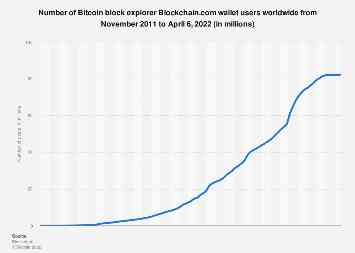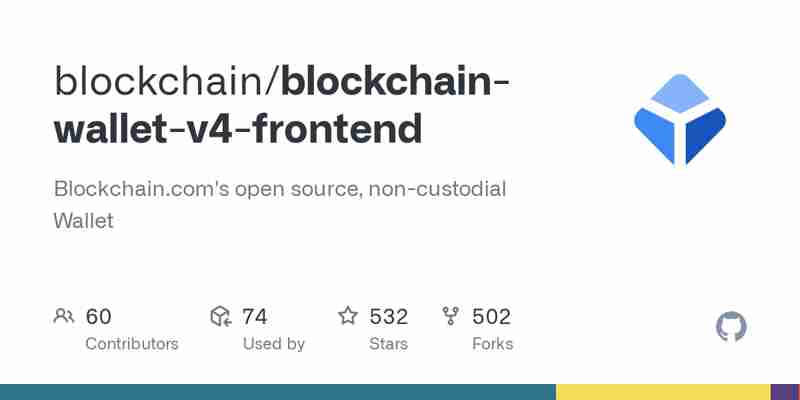Blockchain
Need a Crypto Wallet? Get the Edge Wallet to Manage All of Your Crypto Assets
• Blockchain.com wallets 2011-2022
KPIs for more than 20,000 online stores

Information Design for your projects:
Quick Analysis with our professional Research Service:
Directly accessible data for 170 industries from 50 countries and over 1 Mio. facts.
Everything you need to know about the industry development
Figures and insights about the advertising and media world
Insights into the world’s most important health markets
Insights into the world's most important technology markets
Identify market potentials of the digital future
Everything you need to know about Consumer Goods
All key figures about countries and regions
Detailed information about political and social topics
Consumer and brand insights and preferences in various industries
Key figures and rankings about companies and products
Industry and market insights and forecasts
Overview and forecasts on trending topics
Number of apps available in leading app stores Q1 2022
Please create an employee account to be able to mark statistics as favorites. Then you can access your favorite statistics via the star in the header. Register now
Currently, you are using a shared account. To use individual functions (e.g., mark statistics as favourites, set statistic alerts) please log in with your personal account. If you are an admin, please authenticate by logging in again. Login
Statista Accounts: Access All Statistics. Starting from $468 / Year
Basic Account Get to know the platform You only have access to basic statistics. Single Account The ideal entry-level account for individual users Instant access to 1m statistics
to 1m statistics Download in XLS, PDF & PNG format
in XLS, PDF & PNG format Detailed references $59 $39 / Month * in the first 12 months Corporate Account Full access Corporate solution including all features. * Prices do not include sales tax.
Statista Accounts: Access All Statistics. Starting from $468 / Year Learn more about how Statista can support your business. Request webinar
Blockchain. (April 7, 2022). Number of Bitcoin block explorer wallet users worldwide from November 2011 to April 6, 2022 (in millions) [Graph]. In Statista . Retrieved June 07, 2022, from
Blockchain. "Number of Bitcoin block explorer wallet users worldwide from November 2011 to April 6, 2022 (in millions)." Chart. April 7, 2022. Statista. Accessed June 07, 2022.
Blockchain. (2022). Number of Bitcoin block explorer wallet users worldwide from November 2011 to April 6, 2022 (in millions) . Statista . Statista Inc.. Accessed: June 07, 2022.
Blockchain. "Number of Bitcoin Block Explorer Blockchain.Com Wallet Users Worldwide from November 2011 to April 6, 2022 (in Millions)." Statista , Statista Inc., 7 Apr 2022,
Blockchain, Number of Bitcoin block explorer wallet users worldwide from November 2011 to April 6, 2022 (in millions) Statista, (last visited June 07, 2022)
blockchain/blockchain-wallet-v4-frontend: Blockchain.com's open source, non-custodial Wallet
Wallet

Be Your Own Bank at Please contact support if you have any issues using the wallet.
About
This repo contains the three codebases/packages listed below.
Packages
blockchain-info-components The shared UI components library.
blockchain-wallet-v4 The functional library for handling wallets.
blockchain-wallet-v4-frontend The frontend application built with React/Redux.
Local Development
Ensure Node version >= 14.16 is installed. Using NVM is recommended. From the project root, run the following command to install dependencies: ./setup.sh . Start the application in development mode: yarn start The frontend application will now be accessible via browser at localhost:8080
If you require the application to run locally over HTTPS, follow the instructions here. You can disable SSL by setting the DISABLE_SSL env param to true with any start command. (e.g. DISABLE_SSL=true yarn start:staging )
Windows Support
To ensure proper support for Windows, please take the following actions before running the above setup instructions.
Open a Powershell window with rights elevated to an Administrator. Run npm install -g windows-build-tools . This will install Python 2.7 and Visual C++ Build Tools which are required to compile some native Node modules. Ensure Python has been added to your environment variables by opening a cmd prompt and typing python . If you get a CommandNotFoundException message, add the folder to your environment variables.
Tips & Useful Commands
To completely remove all dependencies and artifacts run yarn clean To add/remove an NPM package run yarn add or yarn remove in the package folder. After installing or uninstalling a NPM package, run yarn in the root folder to re-init the project All development specific dependencies should be installed as a dev-dependency in the top level package.json via yarn i --save-dev [package-name] All application specific dependencies should be installed in the specific packages package.json via yarn i --save [package-name]
Running Environments Locally
The frontend application can be ran locally with different build configurations found in config/env . The following commands are available:
yarn start Runs the application with the development.js configuration file
Runs the application with the configuration file yarn start:dev Runs the application with the development.js configuration file
Runs the application with the configuration file yarn start:staging Runs the application with the staging.js configuration file
Runs the application with the configuration file yarn start:prod Runs the application with the production.js configuration file
Runs the application with the configuration file yarn run:prod Runs the application mimicking the production environment entirely code is bundled and minified, HMR is disabled, Express server is used ( ./server.js ) and the production.js configuration file is loaded)
Notes:
Developers will need to manually create the development.js and staging.js files
and files Custom application runtimes are possible by modifying the corresponding environment files found in the config/env folder
Useful Chrome Extensions
React Developer Tools Inspect the React component tree
Redux DevTools View/debug Redux state changes
Release Process
Prerequisites
To be able to create a release follow these steps starting with "Obtain a personal access token...":
GITHUB_TOKEN should be saved as RELEASE_IT_TOKEN instead in your bash_profile or wherever you keep env variables
You'll need git changelog to generate the history since the last release: npm install -g changelog
Release Steps
From the tip of the development branch, run yarn release Answer the questions prompted via CLI, accepting the defaults for each Once completed, this will create a new tag which will trigger a builds Once builds have finished, deploy the images to desired environments Test and verify the latest changes in desired environments Create PR to merge the HEAD of development into master Merge PR to master so that master always reflects what is currently in production
Code Quality
yarn vet Runs Prettier, lint JS, lint CSS and finally all unit tests
Linting
We follow the rules outlined by the Javascript Standard Style as well as a few React specific rules.
Code linting is handled by ESLint. The following commands are available:
yarn lint Lints all packages
Lints all packages yarn lint:components Lints only blockchain-info-components
Lints only blockchain-info-components yarn lint:core Lints only blockchain-wallet-v4
Lints only blockchain-wallet-v4 yarn lint:frontend Lints only blockchain-wallet-v4-frontend
Lints only blockchain-wallet-v4-frontend yarn lint:fix Automatically resolves fixable issues via ESLint
These IDE plugins/packages assist with complying with these lint rules while developing:
Prettier
We follow all standard rules that are provided by Prettier. The following commands are available:
yarn prettier Runs Prettier against all packages
Runs Prettier against all packages yarn prettier:components Runs Prettier against only blockchain-info-components
Runs Prettier against only blockchain-info-components yarn prettier:core Runs Prettier against only blockchain-wallet-v4
Runs Prettier against only blockchain-wallet-v4 yarn prettier:frontend Runs Prettier against only blockchain-wallet-v4-frontend
It is recommended to setup a Prettier plugin for your IDE plugins/packages that will automatically prettify your files on save.
When installing the plugin for VS Code make sure you are on v3.7.0 or lower
Unit Tests
Testing is done via Jest and Enzyme.
Running Tests
yarn test Runs unit tests for all packages
Runs unit tests for all packages yarn test:components Runs unit tests for only blockchain-info-components
Runs unit tests for only blockchain-info-components yarn test:core Runs unit tests for only blockchain-wallet-v4
Runs unit tests for only blockchain-wallet-v4 yarn test:frontend Runs unit tests for only blockchain-wallet-v4-frontend
Note: if you see errors that Jest cannot resolve package imports, you may need to run yarn test before testing specific packages (eg, yarn test:frontend )
Running Tests via Watch
yarn test:watch Watches and then runs desired tests
Watches and then runs desired tests yarn test:components:watch Watches and then runs desired tests for only blockchain-info-components
Watches and then runs desired tests for only blockchain-info-components yarn test:core:watch Watches and then runs desired tests for only blockchain-wallet-v4
Watches and then runs desired tests for only blockchain-wallet-v4 yarn test:frontend:watch Watches and then runs desired tests for only blockchain-wallet-v4-frontend
Debugging Tests
To enable debugging for unit tests via the Chrome browser, run the following commands:
yarn test:components:debug Debugs unit tests for only blockchain-info-components
Debugs unit tests for only blockchain-info-components yarn test:core:debug Debugs unit tests for only blockchain-wallet-v4
Debugs unit tests for only blockchain-wallet-v4 yarn test:frontend:debug Debugs unit tests for only blockchain-wallet-v4-frontend
After running one of the above commands, Node will wait for a debugger to attach before starting the tests. To attach, simply open your browser and go to chrome://inspect and click on "Open Dedicated DevTools for Node", which will give you a list of available node instances you can connect to. Click on the address displayed in the terminal (usually localhost:9229) and you will be able to debug tests using Chrome's DevTools.
Updating Snapshot Tests
We are snapshot testing UI some components. Here are the commands to update them when necessary:
yarn test:components:update Updates component snapshots for only blockchain-info-components
Updates component snapshots for only blockchain-info-components yarn test:frontend:update Updates component snapshots for only blockchain-wallet-v4-frontend
Code Coverage
To generate code coverage reports via Istanbul, the following commands are available:
yarn coverage Generates a coverage report for all packages
Generates a coverage report for all packages yarn coverage:components Generates coverage report for only blockchain-info-components
Generates coverage report for only blockchain-info-components yarn coverage:core Generates coverage report for only blockchain-wallet-v4
Generates coverage report for only blockchain-wallet-v4 yarn coverage:frontend Generates coverage report for only blockchain-wallet-v4-frontend
Depending upon which coverage report was ran, the results can be found in the following directories:
coverage/index.html
coverage/blockchain-info-components/index.html
coverage/blockchain-wallet-v4/index.html
coverage/blockchain-wallet-v4-frontend/index.html Simply open the index.html file in your browser to view.
TypeScript
TypeScript is supported and should be used when adding new code. It's also recommended to replace legacy JS with TS when time allows.
TS Coverage
We are using Codechecks and Typecov for coverage reporting. Coverage is automatically analyzed for PRs and the following command is available.
yarn codechecks
Code Bundle Analysis/Reports
To visualize and interact with the tree of the production code bundles files:
yarn analyze Once completed, a browser will automatically open with the results.
Storybook
Storybook is used by the blockchain-info-components and blockchain-wallet-v4-frontend packages to interactively view, develop and test components. The following commands are available:
storybook:build-wallet : Builds the static storybook assets for wallet specific components (if base components is running locally, storybook will put wallet and base components into the same storybook UI)
: Builds the static storybook assets for wallet specific components (if base components is running locally, storybook will put wallet and base components into the same storybook UI) storybook:build-base : Builds the static storybook assets for base shared components
: Builds the static storybook assets for base shared components storybook:serve-wallet Builds storybook assets and then serves them locally at localhost:6006
Builds storybook assets and then serves them locally at storybook:serve-base Builds storybook assets and then serves them locally at localhost:6007
Builds storybook assets and then serves them locally at storybook:deploy-wallet Builds storybook assets and then serves them to github pages. You will probably need to run cd ./packages/blockchain-info-components && git remote add origin first.
Builds storybook assets and then serves them to github pages. storybook:deploy-base Builds storybook assets and then serves them to github pages. You will probably need to run cd ./packages/blockchain-info-components && git remote add origin first.
If the deploy begins to fail, deleting the static build file before redeploy will likely help.
Contribute
Please review to the Wiki
Security
Security issues can be reported to us in the following venues:
Need a Crypto Wallet? Get the Edge Wallet to Manage All of Your Crypto Assets
Private By Default

Edge has a zero-knowledge security architecture meaning we don’t need, nor do we want, any of your private information. Respecting your privacy is a core value in everything we engineer.
Your assets. Your keys.
Client-side encryption means all of your data is encrypted on your device before any of your information touches our web servers. No server-side hacks and no malware = safe assets. Only you and you alone have access to control your cryptocurrency assets — the way it should be.
